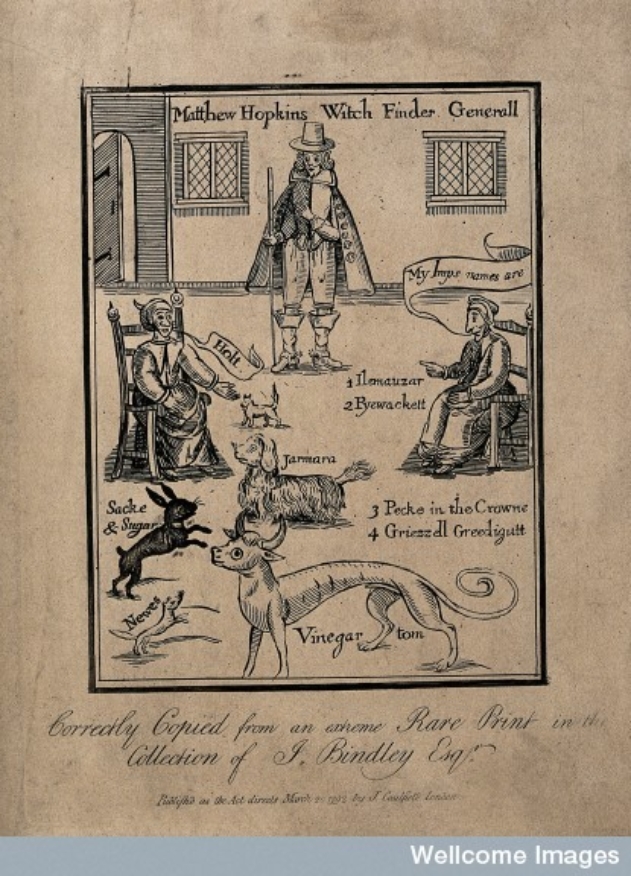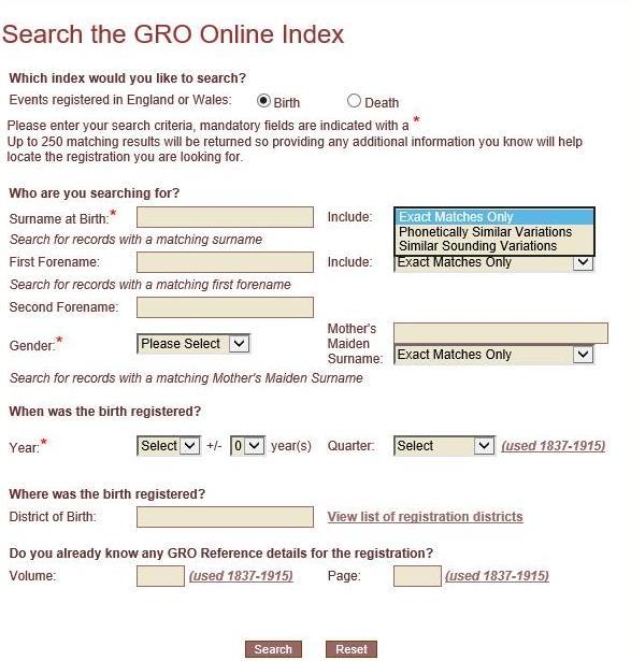The Witchfinder General: Halloween Guest Post
Helen Barrell - FreeREG transcriber and writer of historical crime fiction and non-fiction describes how she uncovered records pertaining to the 'Witchfinder General' in the parish registers of Essex and Suffolk.
One of the biggest witch-hunts in English history began in the village of Mistley in north-east Essex in 1644. When I began to transcribe Mistley’s parish register covering that period, I expected to find the names of those caught up in the panic. But the register unlocked clues as to the power structures in the area that helped to bring Matthew Hopkins, self-styled Witchfinder General, to prominence.
After three years of inducing terror and extracting false confessions under duress, Hopkins died and was buried in Mistley, on 12 August 1647. A note in the register tells us that he was the son of Mr James Hopkins, Minister of Wenham – about eight miles away from Mistley, over the border in Suffolk.
(Courtesy of Essex Archives Online. D/P 343/1/1)
The reason for Hopkins being in Mistley had been shrouded in mystery. What brought him there from Suffolk? Why was he buried in the place where he started his witch-hunt?
As I was transcribing the register, picking up every name as I worked my way through it, I wondered if there were any other people called Hopkins in the register – did Hopkins have any family who had travelled to Mistley with him?
This led me to the burial in 1641 of John Hopkins, with the handy note “son of Marie Hopkins (wife to Mr. Tho. Witham, parson).” So there we have our explanation for why Matthew Hopkins was in Mistley – his mother had married the vicar, after the death of his father in 1634. And John Witham, who performed Hopkins’ burial, was his stepbrother.
I wondered if the family of Thomas Witham could shed any light on Hopkins. Witham was inducted into Mistley’s church in 1610, when at once - and I’m sure other transcribers will recognise my joy at this - his beautiful, clear handwriting appears in the register. He kept the records neatly for over thirty years, carefully numbering each entry. He was fond of adding a distinctive trefoil design with a long tail, and whenever a record related to someone in his family, he often wrote the name twice the size of everyone else’s.
(Courtesy of Essex Archives Online. D/P 343/1/)
From 1613 until 1629, the baptisms of seven children of Thomas and his wife were recorded in Mistley’s parish register. His wife was named Free-gift, a presumably Puritan name, perhaps an Anglicised version of “Dorothy”, which means “Gift of God”. She died in 1633.
Between 1630 and 1639, four brides with the maiden name “Witham” married at Mistley. Two of them, Marie and Dorcas, match up with daughters of Thomas and Free-gift, but two other brides, Anne and Susan Witham, do not. However, when we come to the baptism of Susan’s children by her husband Richard Edwards, the names are written in the same large writing that Thomas Witham used for his family. So it seems likely that Susan, and perhaps Anne too, were also children of Thomas and Free-gift, perhaps born before Thomas became Mistley’s vicar.
This is important to note, because it was the death of one of the Edwards’ children which helped to spark off the witch panic. Richard was an extremely important man in north-east Essex, a wealthy landowner who was also chief constable of the Tendring Hundred - the area where Mistley lies. By 1643, Thomas Witham had gone to London to preach, leaving his church vacant. It seems that Matthew Hopkins, as son and stepson of clergymen, had influence, as would Richard Edwards. And if Edwards’ wife was Hopkins’ stepsister, then it was the death of his stepsister’s child, apparently by witchcraft, that set him off on his career as The Witchfinder General. It was perhaps not random rage, but targeted revenge.
But it’s not only in Mistley that we find the Witham family connecting with a prime mover in the witch panic. Bradfield, the parish immediately to the east of Mistley, was the home of Sir Harbottle Grimston, who sounds like a villain in a Dickens’ novel. He was a very important man, and as a Justice of the Peace (along with Sir Thomas Bowes, my great-several times uncle, I’m sorry to say), helped Hopkins in his schemes to prosecute witches.
I’m currently transcribing Bradfield’s earliest register, and came across the Grimston family in the 1500s - Harbottle was baptised there in 1578. Then in the 1620s, familiar handwriting appeared in the register, and I even spotted a stylised trefoil - was this Thomas Witham? But a note in Latin helpfully informed me that one Peter Witham, alumnus of Sidney Sussex College, Cambridge, became the reverend incumbent of Bradfield in 1628.
As it’s been a couple of years since I originally transcribed Mistley’s registers, I looked back at my notes and found a snippet from the Alumni Cantabrigiensis, which contains a brief biography of students who studied at the University of Cambridge. Peter Witham and Thomas Witham both appear, and Alum. Cantab. says that they were brothers. To be honest, I could have guessed that from the near-identical handwriting! Although of course, who knows - perhaps Thomas used to pop over the parish border to write up all the baptisms, marriages and burials for his brother in his beautifully neat handwriting? Although the Mistley register has “baptised” and the Bradfield register “baptized” - would one man change his spellings? But, just like Thomas’ habit when recording family events, when Peter’s son was baptised in 1630, the entry was written in larger writing.
(Courtesy of Essex Archives Online. D/P 173/1/1)
During Peter Witham’s incumbency at Bradfield, three records pertaining to Sir Harbottle’s family were entered in the register: three of his grandchildren, none of whom were actually baptised in Bradfield as they were all born in London. They take up half the length of a page, with full details about where they were born, what time of day, and other details - far more information by some way than is included in the entries for the mere ordinary folk of Bradfield.
Considering what I had surmised regarding Matthew Hopkins’ relationship to the Witham family and their involvement in the witch panic, I wondered if here, again, we had evidence of the close-knit networks of power in the area. Peter Witham was stepuncle to The Witchfinder General, and he seems to have been close to Sir Harbottle Grimston, or at least acquainted with him, as the vicar would be with the local gentry. Although Peter Witham left Bradfield in 1633, just before Hopkins would have arrived in Mistley, a connection had been made between the Grimstons and the Withams during his incumbency.
So Matthew Hopkins wasn’t in Mistley by accident. He had lived there since boyhood, and was connected with the most powerful men in the area. It is no surprise, then, that when Civil War came and unrest and panic afflicted the populace, he could rise to prominence as The Witchfinder General.

(Courtesy of Wellcome Images)
Parish register images: courtesy of Essex Archives Online. No further reproduction is allowed images unless with written permission from the Essex Record Office.
Additional information:
For a fascinating and eminently readable study of Matthew Hopkins, see: Malcolm Gaskill, Witchfinders: A Seventeenth-Century English Tragedy. London: John Murray, 2005.
Great Wenham’s earliest register hasn’t survived, so no record of Matthew Hopkins’ baptism exists. Thomas and Peter Witham were born in Steeple in Essex, according to Alum. Cantab., but the earliest register for Steeple hasn’t survived either.
Manningtree was part of the parish of Mistley until the late 1600s. Richard Edwards is stated as being of Manningtree on his statements that he gave alleging witchcraft against several local women.
About the Author:
Helen Barrell is a librarian and an author. She has appeared on BBC Radio 4’s Punt PI and her Victorian true crime books Poison Panic and Fatal Evidence are published by Pen & Sword. www.essexandsuffolksurnames.co...



